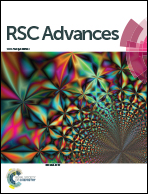Fluorescence quenching of 1-pyrene-carboxaldehyde by iodide ions in the presence of anionic (SDS) and cationic (CTAC) micelles: a quantitative treatment†
Abstract
The quenching of the fluorescence of 1-pyrene-carboxaldehyde by iodide ions has been studied in the presence of micellar solutions of CTAC and SDS. In the presence of the latter surfactant, the fluorophore accumulates at the micelles whereas the quencher is repelled from the aggregates. Consequently, a decrease of the quenching is observed when the concentration of micelles increases. In the CTAC case, both the 1-pyrene-carboxaldehyde and the iodide ions accumulate on the micelles, so that a maximum in the quenching is observed (see Fig. 3). These facts can be formally rationalized using the pseudophase model. However, the meaning of the parameters appearing in the equations of this model are, for photochemical quenching processes, different from those corresponding to ground state reactions. The quantitative analysis of the parameters has been carried out employing a formulation previously developed by us, which is extended here in order to take into account the particular characteristics of micellar solutions.


 Please wait while we load your content...
Please wait while we load your content...